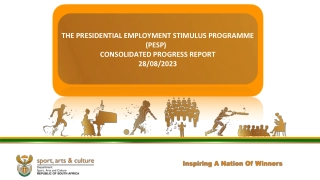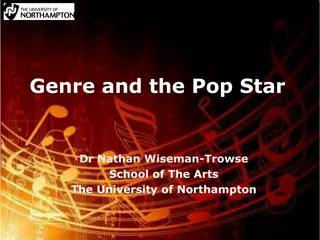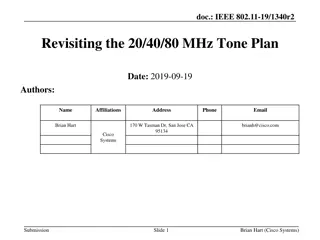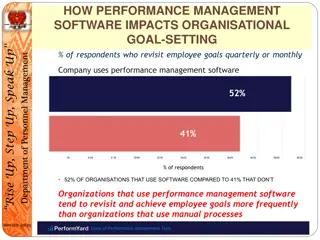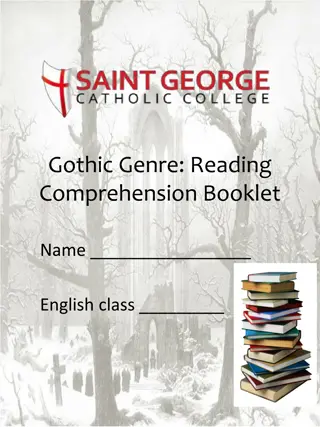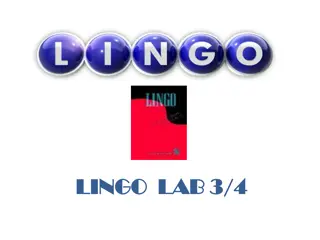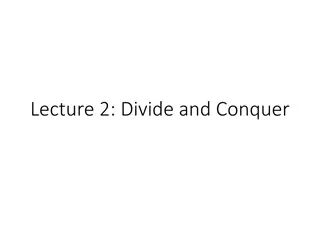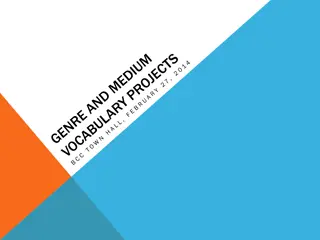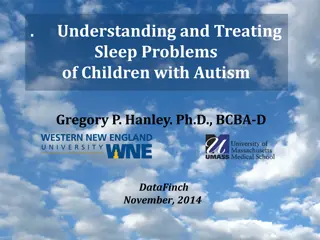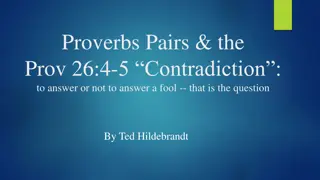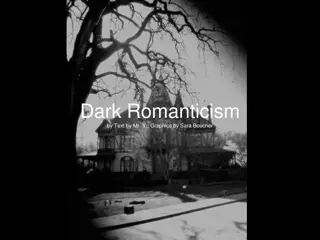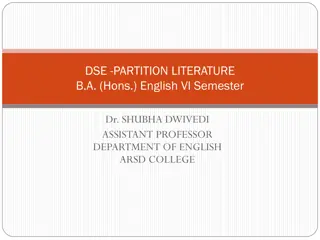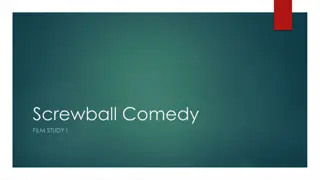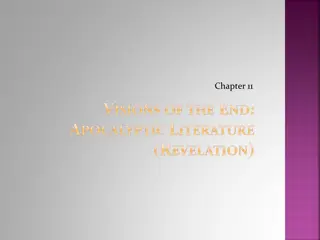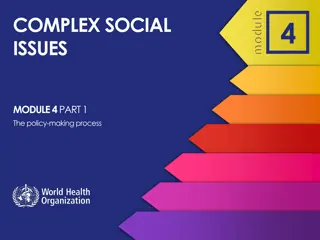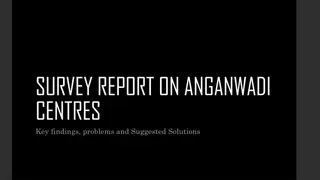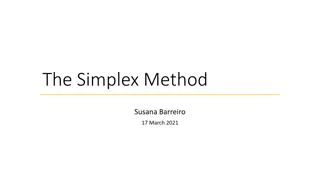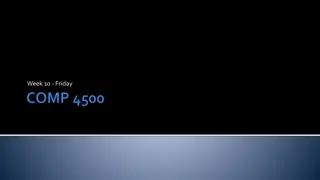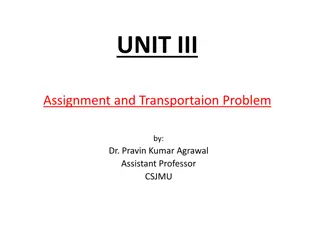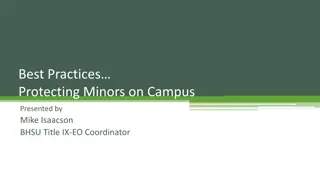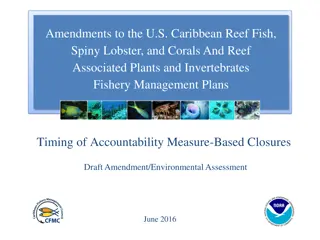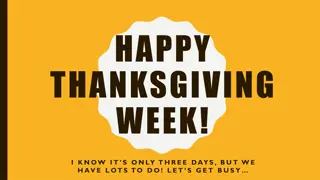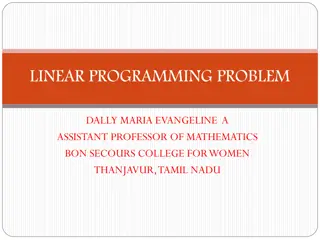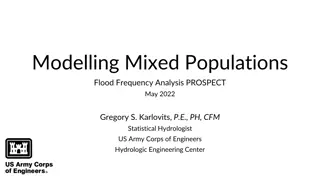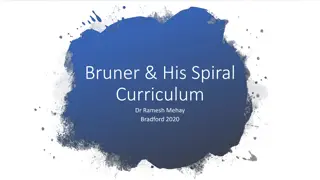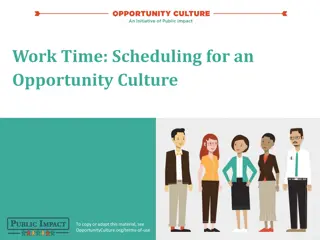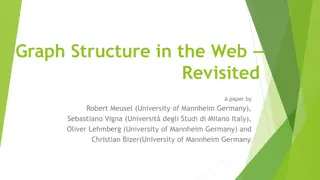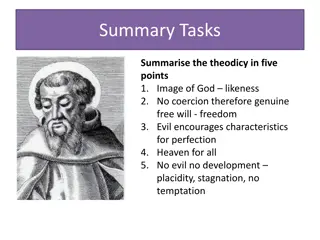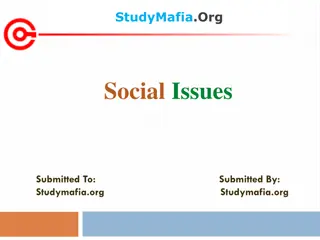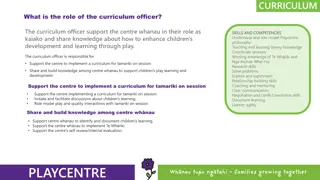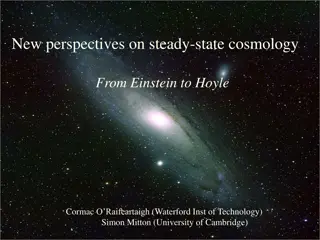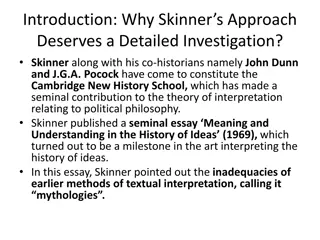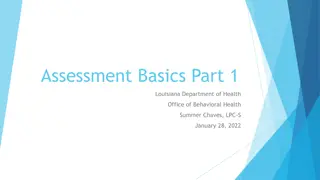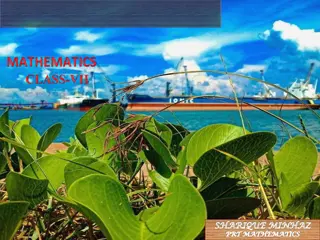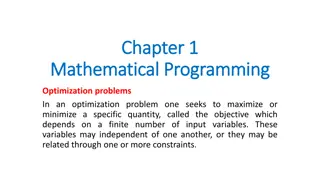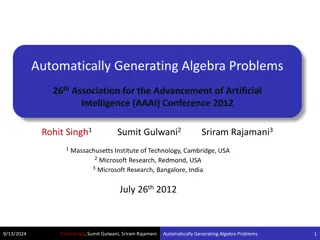Revisiting PESP Genre: Problems, Issues, and Solutions
This discussion revisits the problems and issues associated with communicative purpose and social purpose in ESP/Swalesian genre analysis. It delves into the definition and differentiation of communicative purpose (CP) and social purpose (SP), offering insights into their roles in text classification and genre identification. The nature and formulation of rhetorical moves are also explored in the context of genre-based teaching and learning.
Download Presentation

Please find below an Image/Link to download the presentation.
The content on the website is provided AS IS for your information and personal use only. It may not be sold, licensed, or shared on other websites without obtaining consent from the author. Download presentation by click this link. If you encounter any issues during the download, it is possible that the publisher has removed the file from their server.
E N D
Presentation Transcript
P ESP Genre revisited: PROBLEMS, ISSUES AND SOLUTIONS (Philip Nathan, Dr. University of Durham
Problems and Issues Covered Communicative purpose and social purpose The nature of rhetorical moves Analysis of genres Impact of Swalesian ESP genre theory in the EAP classroom Effectiveness of genre-based teaching and learning (and other research needed)
Communicative purpose and social purpose Communicative purpose (CP) is central to ESP/Swalesian genre analysis {Swales, 1990, p.57), Askehave and Swales (2001) CP being a privileged criterion in the assignation of genre identities. Nesi and Gardner (2012: 26, 34, 35, 57) operating in the EAP context, use social purpose (SP) as the basis for their text classification (As do Martin and others e.g., Martin and Rothery, 1981, from the Australian genre school). Sometimes writers just use the term 'purpose'. Sometimes CP and SP are used as if the same (Nesi and Gardner, 2012, p.27) What is CP? What is SP? Are these different/the same? Do they overlap? It would be useful to have these defined or described. No definition of CP in Swales (1990) as far as I can find (or in Swales, 2004) and no discussion as to why CP should be used instead of SP. Why do Nesi and Gardner use SP rather than CP? Of course, there will be justification for this but the SP and not CP. CP allows flexibility in terms of the element having the purpose (the speaker, society) so could potentially include social purpose whereas social purpose is used is applied to the text/genre.
Communicative purpose and social purpose Communicative purpose Chandler and Munday s (2012) dictionary definition the primary goal and intention of anyone involved in an action of communication, on a given occasion ) to which I would add "framed in terms of the desired effect of the communication action on the speaker/recipient" For example, for a business case report on an academic programme a summary/broad CP might be "to persuade the lecturer reader that I (the writer) knows, understand(s) and can apply business theory in a realistic business context" Social purpose I would define this as perhaps uncontroversially: "the role that a text performs in the social community. " So, for a business case report, the social purpose might be framed as "to act as a vehicle for preparing students for professional practice" (modified from Nesi and Gardner. 2012) or more specifically "to act as a vehicle for the demonstration and development of professional practice through the analysis of a single exemplar" (modified from Nesi and Gardner, 2012: 41, and 2013:37 in this latter, the term 'educational purpose' is used by the authors).
The nature (and formulation) of rhetorical moves Moves are: the building blocks of communicative structure (Nathan, 2010, p.51) Moves are rhetorical instruments that realise a sub-set of communicative purposes associated with a genre (Bhatia, 2002, p.84-85). Swales (2004: 228-229) describes the move as a term of art and as a discoursal and rhetorical unit performing a coherent communicative function. Swales goes on to state that the identification and setting of move boundaries is established by a mixed bag of criteria which produce defensible action criteria in a process which is essentially bottom-up in nature. If you want a fuller review of discussion about the nature of moves and their determination, then I reviewed these in my, slightly outdated doctoral thesis (2010).
The nature (and formulation) of rhetorical moves Is an RA introduction not a move? Is an RA conclusion not a rhetorical move? Why is "Establishing a territory" a move but not "Introducing the research article" Introductions perform a coherent communicative function, as do conclusions. For me, these can be seen as rhetorical moves. Nesi and Gardner (2010) refer to introduction as a stage Young (1994) refers to phases in texts. But aren t all key sections of research articles, theses, dissertations et al., in fact moves themselves?
The nature (and formulation) of rhetorical moves Swales identifies, within the structure of rhetorical moves, steps that are available to realise those moves. Bhatia (1993) used the term sub-moves. There may be sub-sub-moves realising sub-moves and even greater depths of move structures possible, as shown in the options analysis sections of business case reports (Nathan, 2016) . Thus, Swales's stages themselves can perhaps be seen as forms of move (sub-moves etc.)
The nature and formulation of rhetorical moves If an introduction and other similar structures can reasonably be considered as moves, then I would suggest that these are not referred to as stages or phases but as MACROMOVES. This allows for consistency of terminology with MACROMOVES, MOVES and SUB-MOVES (and SUB-SUB etc) forming a coherent set of labels for itemising how the rhetorical purposes of texts are realised.
The nature and formulation of rhetorical moves CP is a key determinant of genres and central to genre analysis. Formulations/labelling of moves is often divorced from purpose formulated in terms of intended effect on the reader/recipient. This may be for purposes of abbreviation, however for teaching and other purposes, providing explanation of the goal of a move in terms of effect on the reader/recipient seems crucial to me and where possible should inform labelling of moves. In practice the RA move "establishing a niche" might perhaps become "Providing the reader with key conceptual information, supporting understanding of the research area"; also "Convincing the reader of the importance of the research topic/area" ; "Contextualising the research for the reader" [three moves not as metaphorical as the current designation perhaps in the search for a brief label, we lose key information about moves.
Cyclicity and other patterns in move analyses A range of cyclic move patterns have been identified for example in move analyses of biochemistry research articles (Kanoksilapatham, 2005) Options analysis sections of pedagogical business case reports (Nathan, 2016), software engineering research articles (Posteguillo, 1999) and research articles in general (Swales, 2004) . However there still seems to be a preference for identifying linear, non-repetitive patterns. A more widespread acceptance of the prevalence of repetitive, cyclic, repetitive patterns would enhance genre research and likely pedagogy. Essays, a key genre family in university student academic writing, have been seen as not- susceptible to Swalesian genre analysis (Dudley-Evans, 1998) but the broader acceptance of and search for cyclicity and other patterning may make such analyses more applicable.
Cyclicity and other patterning in genre analysis Introductory move Move cyclicity in options analysis sections of business case reports (Nathan, 2016) Move
Cyclicity and other patterning in genre move analysis an expository argument (1) Orientation to proposition [statement of proposition] (2) Orientation to argument structure [Two moves in one sentence] (1) Present justification/rationale 1 in support of proposition by. (i) sub-move 1 Specifying the topic area of the justification [orient the reader to the first justification for the proposition] (ii) sub-move 2 Excluding part of the topic area (iii) sub-move 3 Specifying the precise rationale 1 for supporting the proposition. (1) Present justification/rationale 2 in support of the proposition by (i) Sub-move 1: Stating the justification for rationale 2 (ii) Sub-move 2: Specifying the rationale
Impact of ESP Genre theory on EAP teaching We don t really have much measure of the impact of genre theory, and in particular rhetorical move analysis in teaching in EAP. The essay is a key genre family (43% of assignments in the BAWE corpus) but structure here MAY still be taught simply using Introduction, body, conclusion as the core elements of essays with little reference made to Nesi and Gardner s research and the research of others, and little focus on rhetorical moves. RAs and PhD writing may be somewhat more tied in terms of their teaching and learning to genre ideas (but again these is little systematic evidence) We may teach about stance (hedging and boosting, and in various other forms), paragraph structure, use of conjunctions, argument structure, citation format and topic sentences but to what extent are these tied to the notion of Swalesian genre in our EAP teaching, and indeed should they be?
Impact of ESP genre theory on EAP teaching A number of basic EAP coursebooks (Oxford ESP pre-intermediate; Access EAP frameworks foundation level) I have looked at don t mention genre which is seen as an advanced/upper intermediate concept (present in Oxford EAP C1 level though not in relation to essays). Course materials I have viewed for various presessional programmes have little focus on genre but focus more on concepts such as argument, paragraph structure, cohesion and coherence, hedging and so forth in ways which are not tied to genre but in a more general EAP sense. We need a more systematic overview of the influence of Swalesian genre approaches on EAP teaching and learning.
Research on the effectiveness of genre teaching and learning There has been some research on the effectiveness of genre teaching and learning, however with regard to some if not the major key university genre and contexts there is little research published. We have (Hyon, 2017: 79-80) research on learning to write various genres: tourist information brochures (Henry and Roseberry, 1998) film reviews (Pang, 2002) email messages (Yasuda, 2011) literature reviews (Dovey, 2010) research articles (Cheng A. (2008) case study with focus on one student out of 22 students in the class. There is no substantive effectiveness research that I can identify tied to essay assignments and many other genres (including indeed masters and doctoral theses), which are of key importance in academic settings.
Research needed We need to conduct further research on the extent of impact of Swalesian genre theory on the world of teaching and learning in EAP (and non-impact too). We need to research the effects of our genre teaching and learning on students in situ on their academic first degree and Masters programmes. To what extent do these students think in genre terms, demonstrate and apply genre awareness? Where does genre come into the thinking and writing process? We need further evaluative data in the round. Given the variability of assignments on academic programmes and perhaps a lack of in situ models, we need to research whether it is of value to apply a Swalesian genre approach for much content on academic programmes)
Summary (1)Some nomenclature issues and issues of definition (2)The nature and formulation of rhetorical moves (3)Some issues tied to cyclicity and genre (4)The actual impact of Swalesian genre theory (5)The need for further research
Swales (2019) Genre research is too textual Too thin in context [not thick descriptions I don t think these add much to performance depends on the purpose of the research but they don t tend to explain (in my view) just bamboozle Genre research is too concerned with overall structure It is too interested in the interpersonal and promotional aspects of research writing Over-focused on our own fields of linguistics and ESL.
References Askehave and Swales, (2001) Genre identification and communicative purpose: A problem and a possible solution. Applied Linguistics 22(2) 195-212 Chandler, D. and Munday, R. (2016) Dictionary of media and communication, Oxford University Press, Oxford. Dudley-Evans T. (2001) The teaching of the academic essay. Is a genre approach possible? p.225-236 In Genre in the classroom: Multiple perspectives ed. Johns, A. Lawrence Earlbaum Gardner, S. and Nesi, H. (2013) A classification of genre families in university student writing Applied Linguistics 34/1 25-52. Hyon, S. (2017) Using genre analysis to teach writing in the disciplines p.77-94 in Discipline-specific writing; Theory into practice eds Flowerdew, J and Costley, T. , Routledge, Oxford/New York Kanoksilapatham, B. (2005) Rhetorical structure of biochemistry articles English for Specific Purposes Journal 24 3 269-292 Martin, J.R. and Rothery, J. (1981) Working papers in linguistics, No. 2.
References Nathan, P.B. (2010) A genre-based study of pedagogical business case reports Doctoral thesis Nathan, P.B. (2016) Analysing options in business case reports: Genre, process and language, English for Specific Purposes Journal 44 p.1-15. Nesi, H. and Gardner, S. (2012) Genres across the disciplines; Student writing in higher education, Series editors Chapelle, C.A. and Hunston, S. Cambridge University Press, Cambridge. Posteguillo, S. (1999) The schematic structure of computer science articles English for Specific Purposes Journal 18 2 139-160 Swales, J.M. (1990) Genre analysis: English in academic and research settings. Series Editors Long, M.H. and Richards, J.C., Cambridge Applied Linguistics, Cambridge. Swales, J.M. (2004) Research genres: Explorations and applications Series Editors Long, M.H. and Richards, J.C., Cambridge Applied Linguistics, Cambridge. Swales, J.M. (2019) The future of EAP genre studies: A personal viewpoint. Journal of English for Academic Purposes 38.


